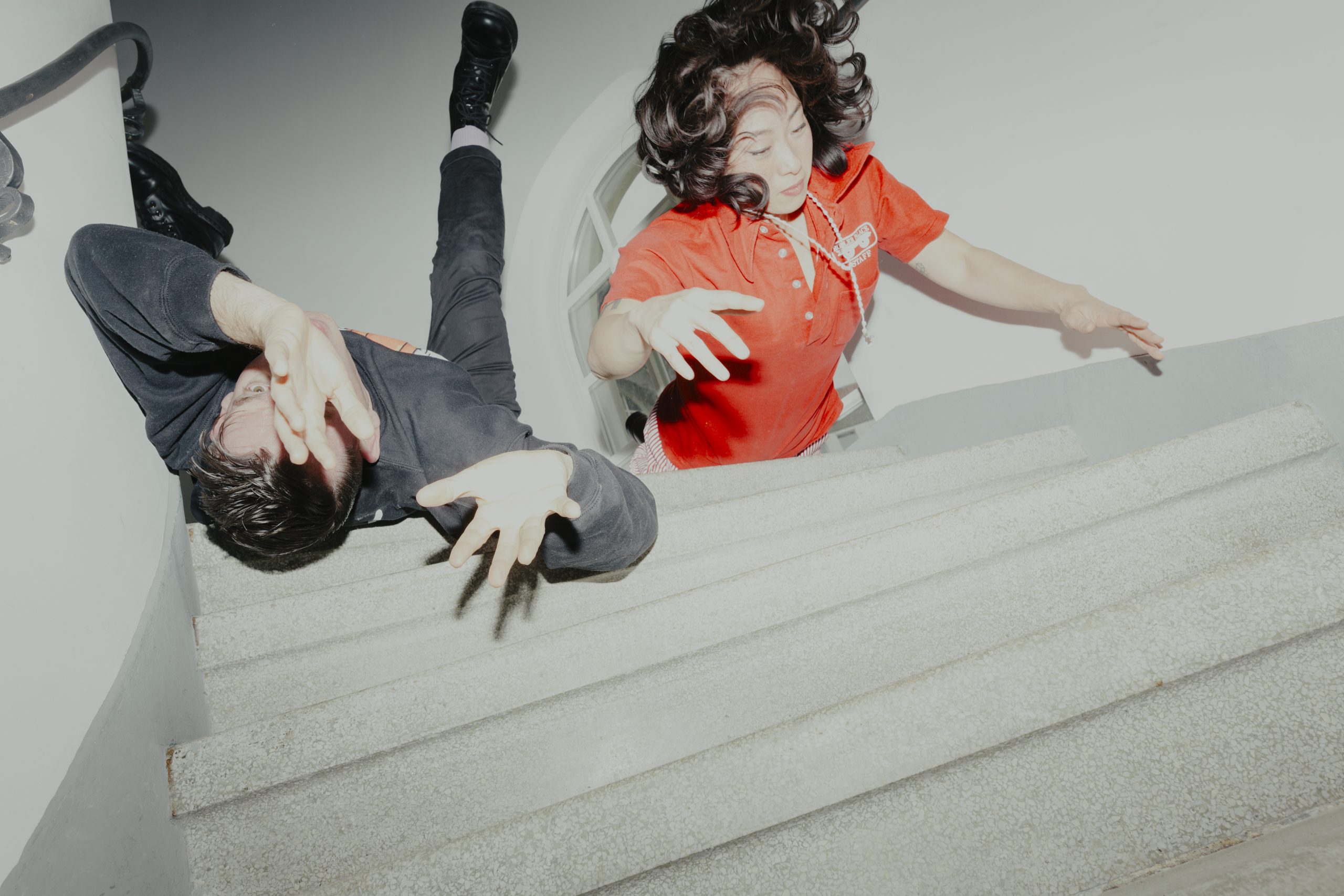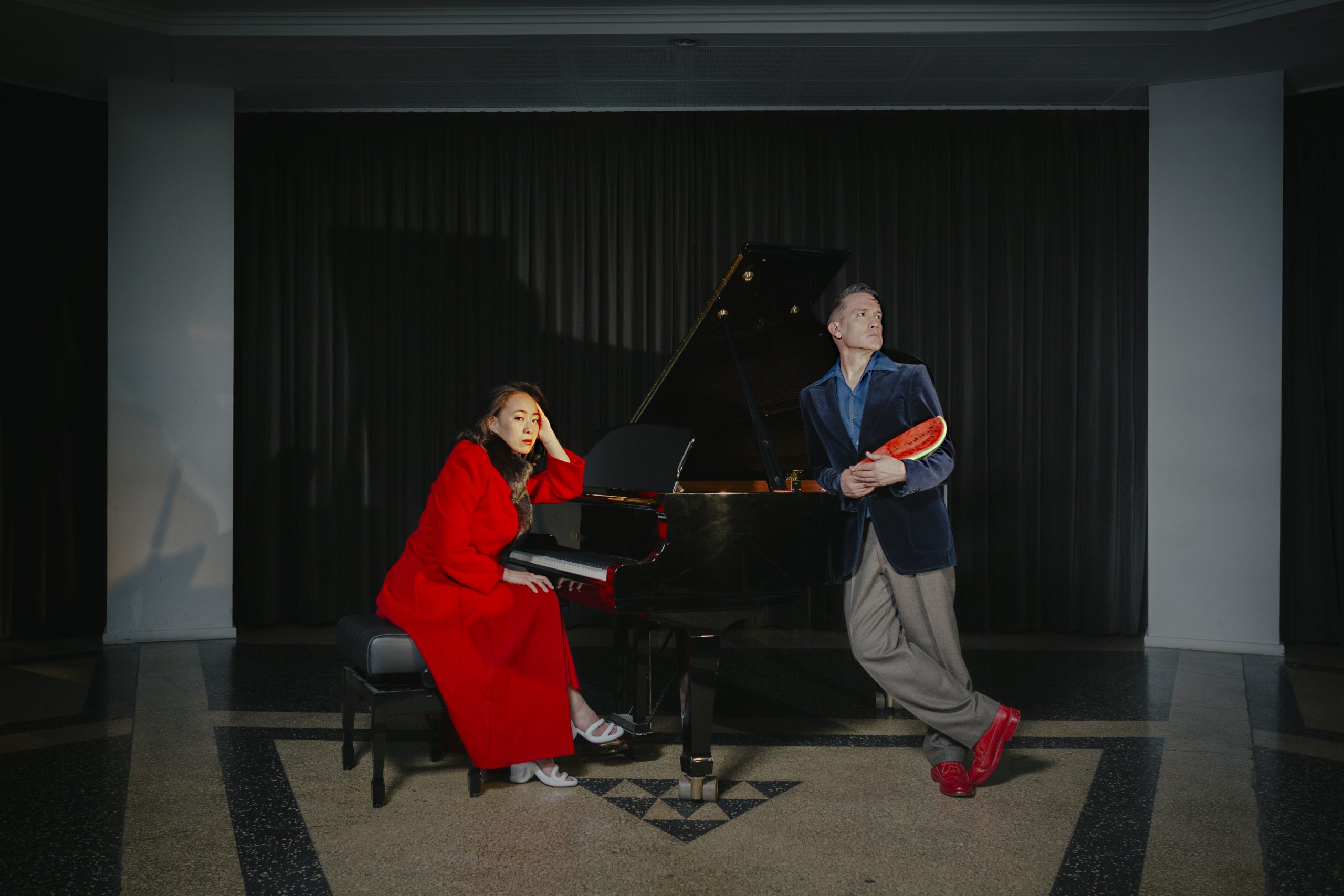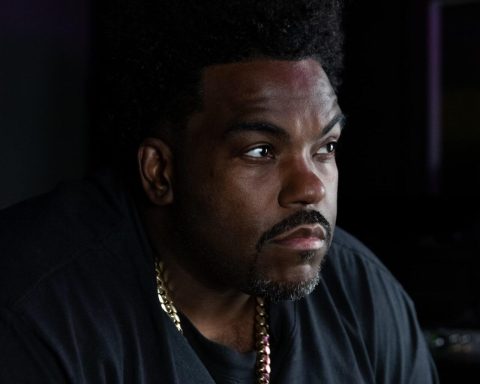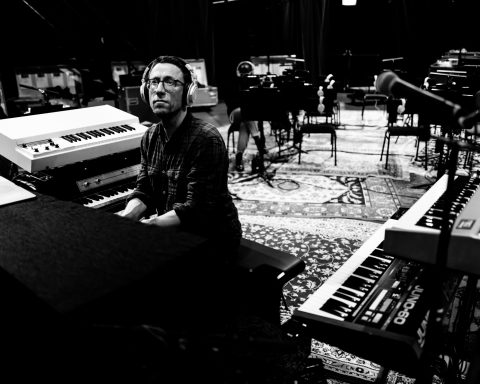Formed in 2002 by singer-songwriter Jamie Stewart, Xiu Xiu epitomizes the characterization of a rock band with their aggressive energy and lyrical themes based on personal tragedy, guilt, and mortality. With their sound described as a “stereoscopic assault” and labeled by critics as “self-flagellating” and “perverse,” Xiu Xiu is keen to stress that their aim has never been to shock.
Having recently relocated from Los Angeles to Berlin, while the line-up has changed over the years, Angela Seo and Sparks/ex-Devo percussionist David Kendrick are now firmly at the group’s core. Known for their use of indigenous percussive instruments and heavy reliance on vintage Roland drum machines, their 17th LP, bizarrely titled 13″ Frank Beltrame Italian Stiletto with Bison Horn Grips, sees Xiu Xiu at their experimental and shape-shifting best.
Shoo Shoos or Shewees?
You’ve previously talked about how people always pronounce the name of Xiu Xiu wrong. Does this remain an ongoing source of amusement?
No one in the band speaks any of the many Chinese dialogues available, so I’m sure we’re saying it wrong, too. We say “shoo shoo” but don’t mind if people pronounce it in one of the 7,000 different ways that they do, but it is amusing when we hear one that we’ve never heard before. Some of our incredibly dedicated fans call themselves “shewees,” and we think that’s pretty cute.
The band’s origins came from the Chinese drama Xiu Xiu: The Sent Down Girl. Why did this movie have such a profound effect on you?
Alongside music, film has always had a massive influence on what we do. I started the band with Cory McCullock, and we both saw the movie during a period in our lives that can only be described as a total disaster. Although we obviously have no connection to the film in terms of the events that took place during the Cultural Revolution of China, Cory and I found a real connection to the movie’s main character because everything she did to attempt to improve her life only made her situation worse.
You moved from LA to Berlin recently. Was that to get away from something that was having a negative influence?
A little bit. I was born and grew up in Los Angeles, but we moved away in 2012 and returned to the city at a time when the city was going through a really positive renaissance. Things were wonderful until the pandemic, but it never really healed, and even when I go back now, the effects of that are still apparent. We had an opportunity to move to Berlin through the generosity of an artist called Silent Green. Angela [Seo] has lived here before, so we have ties to the city, and it was too good an opportunity to pass up.
“Some of our incredibly dedicated fans call themselves 'shewees' and we think that’s pretty cute.”
The Importance of Angela
Many band members have come and gone over the years, but Angela is the steadiest group member you’ve had. What does she bring that’s essential to the Xiu Xiu ethos?
It’s a long list [laughs]. For one, she’s a great keyboard player and an unbridled percussionist. Her style is smashy, but her dedication never fails to convey emotion. From a production standpoint, I tend to be overly detail-oriented, but Angela can see the bigger picture. If there are seven or eight different synth parts, she’ll find the one that best puts the meaning of a song across. Socially, she was my best friend before being in the band, so she’s someone I can count on outside of my musical life, too.
The band has been described as harsh, brutal, and shocking. Do you feel these adjectives accurately represent what Xiu Xiu is trying to convey?
It’s an accurate representation of how people interpret us, and some might find our type of expression harsh and shocking, but we’re not trying to be that. We’re just trying to represent the things that we care about in ways that are true to who we are and genuinely hope that people interpret that in a way that’s honest to them.

Talismanic Objects
I have to ask how you came up with the title for your latest LP, 13″ Frank Beltrame Italian Stiletto with Bison Horn Grips.
It’s a fair question, but I apologize in advance because the answer’s really kind of dumb. When we’re working on records, for no reason that I can explain, there tends to be particular physical objects that become somewhat talismanic and have some subconscious connection to what we’re trying to do. It’s not something that I can explain, but it’s palpable. I do collect switchblades, and the nicest pair in the collection is a 13″ Frank Beltrame Italian Stiletto with Bison Horn Grips. I wrote down a list of ten potential titles, and Angela pointed to that without hesitation. Thankfully, it was the title I secretly hoped she’d choose!
"I wrote down a list of ten potential titles, and Angela pointed to that without hesitation. Thankfully, it was the title I secretly hoped she’d choose!"
In the past, you’ve heavily leaned towards using indigenous percussive instrumentation. Where does this fascination come from?
The sound of field recordings and indigenous music from around the world made its way into my consciousness from a fairly early age and so my ear has always been open to sounds that were a little bit different than just bass, drums, and guitar. When I started, I was actually more interested in engineering and always looking for sounds that I hadn’t heard or used before, so we’ve been able to build a fairly hardy collection of different percussion instruments from all over the world. We don’t ever try to emulate the style on which those instruments are played or co-op that style of music, but the sounds they make remain incredibly interesting to us.
The LP’s closing track, Pina, Coconut & Cherry, is dark, introspective, sorrowful, and one of your best. Can you talk about its derivation and some of the haunting sounds used throughout?
I’m going to tip my hand quite a bit here, but we have a subscription series on Bandcamp, and as part of that, we release a cover version every month. One of those covers was “Heroin” by The Velvet Underground. Angela came into the studio, heard the song, and thought it was cool but didn’t know exactly what I was working on. I was a little embarrassed at having to say it was a cover, but because she appreciated it, I wanted to, not copy “Heroin,” but attempt to write our version of that type of song. We used a lot of different guitars on the track, a few vintage organs and synths, bass, bongos, and some sheet metal. We also used the Roland CR-68, which is my favorite drum machine of all time.
"We used a lot of different guitars on the track, a few vintage organs and synths, bass, bongos, and some sheet metal. We also used the Roland CR-68, which is my favorite drum machine of all time."
A Classic Groove Box
The Roland MC-307 groove box has appeared on all of your albums. What is it about that machine that has allowed it such longevity?
When we started the band, we had an MC-303, which I loved, but we needed something with a slightly bigger memory, so we bought the MC-307 when the sounds seemed very fresh, cool, and of that moment. Ideas around synthesis have developed tremendously since then, but now those sounds seem like they’re literally from another planet. I can use the MC-307 without thinking, and the layout and user interface are great, so there’s no delay in creating some sort of musical expression. I actually have three of them, but they still run as well as they ever did and look cool, too.
Have you found that using the same instrument across a back catalog adds consistency to your sound palette?
Because it’s an older machine, the sequencing capabilities are very metric. People do a lot of sequencing in Ableton now, and you can chop stuff up and move it all over the place, so things can start to sound a little bit clichéd. The MC-307’s sequencer layout is classic, and whenever we use it on a song, it never sounds like we’re trying to emulate a particular microsecond of whatever’s trendy. I’m not trying to over—Roland this, but Roland makes classic sounds, and the reason people still use those sounds in electronic music, and probably always will, is because they’re great.
“Roland makes classic sounds, and people still use those sounds in electronic music because they’re great.”
My Favorite Drum Machine
You mentioned that the CR-68 remains your favorite drum machine ever. What gives it top billing?
I find limitations extraordinarily inspiring, and there’s almost no programming you can do on the CR-68. You can’t change the beats; you can only change if and when a fill comes in, so I like that there’s no hand-wringing over what the groove is going to be. People have been using the CR-68 since the early ’80s because the sounds are spectacularly great, and although the swing doesn’t feel human, it does feel different. Another good thing is that the tempo isn’t totally perfect. Don’t get me wrong, I like the tight, sequenced feeling of the MC-307, but there’s a slight amount of expansion and contraction to the CR-68’s tempo, so when you play along to one, the groove feels more exciting.
What other instruments were complementary to the drum sequences you created on the album?
My dad used to work at Digidesign, which became Avid, so I’ve been using Pro Tools since forever. Our studio isn’t very big, so we tend to use desktop synthesizers instead of full-size keys. We’re not a wealthy band, but when we first started, we used to use plug-ins because we couldn’t afford anything else, but our engineer, John Congleton, encouraged us to start using outboard gear. We use a lot of modular synths and have a pretty hardy pedal collection, so we like to use long chains of pedals and connect them to synths. We also like the Roland SP series samplers—especially for live work.







